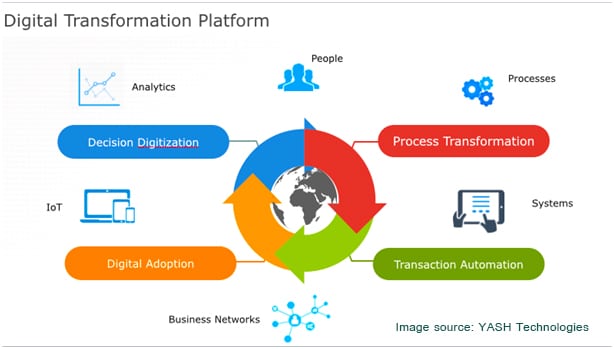
Digital transformation is the integration of digital technology into all areas of a business. Many companies are using digital transformation to renovate their businesses to become more efficient and more profitable.
Digital transformation is all about digitizing everything from analytics to people management and process automation to transaction automation.

Digital Technology and Product Development
Identify some of the technical aspects of a digital transformation that would significantly impact product development and the design of new products and services. The specifics of each of these technologies are changing quite frequently, so below is a list of categories of digital technologies.
- Intelligent devices are products or appliances characterized by sensors or monitors, a user interface, processing capability, and digital communication. As such, these devices are basic computers embedded in a product that is providing additional functionality. Most smart devices can also be customized with a personal profile or programmable functionality that enables the user to create a unique interaction pattern.
- The Internet of Things (IoT) is a digital technology that has overgrown during the past few years. It is characterized by any device or equipment with digital communication capability along with sensors or monitors. The IoT connects devices digitally across a network and allows either one-way or two-way communication.
- Analytics platforms provide aggregation of make into a dashboard or user interface. This enables a customer to monitor and control a process with multiple connected devices. The analytics can also troubleshoot and analyze the performance of the different steps in the process being monitored.
- Digital platforms are software applications that operate over the internet and connect individuals from different user group categories. Through the platform connection, the individuals or corporate entities can exchange information, purchase products or services, and promote a cause or development.

Some of the Benefits of Digital Transformation
The time, effort, and costs needed for a complete digital transformation are substantial, but the potential returns far outweigh them. Here some of the benefits for businesses include:
1.Increased profits
Here is the results reported by the SAP Center for Business Insights and Oxford Economics:
- 80% of organizations that already completed the digital transformation report increased profits.
- 85% have also increased their market share.
2.Increased agility
Digital transformation makes organizations more agile. Borrowing from the world of software development, businesses can increase their agility with digital transformation to improve speed-to-market and adopt Continuous Improvement (CI) strategies. This allows for faster innovation and adaptation while providing a pathway to improvement.
3.Revenue Growth
By minimizing costs, it’s easier to grow revenue. Maximizing opportunities through the recognition of flaws within current business processes is key to driving a company forward.
4.Improved productivity
The right tech tools that work together can streamline workflow and improve productivity. Automating many manual tasks and integrating data throughout the organization empowers team members to work more efficiently.
5.Improved efficiency
Digital transformation eliminates many bottlenecks. When you replace the processes with automated workflows and apply them to your current methods, you reduce friction in your business.
6.Improved customer satisfaction
Offering digital tools to your customers will make their work easier. It makes the business more attractive to potential customers. But, most importantly, it keeps you relevant. Companies that offer an incompetent, out-of-date experience will have trouble competing with those who stay up to date with modern technology.

Summary
Digital age new product development must accommodate the new KPI of customer relationship and engagement. This requires changes in the product architecture and may require significant changes in product designs. The process of product development can be accelerated by using digital technologies. This acceleration is welcome since most products will need a new upgrade or release every few months to stay compatible and competitive. The challenge then for new product development is to manage this increased number of projects effectively.


Leave a Reply